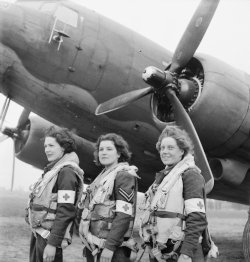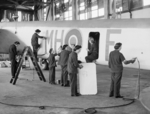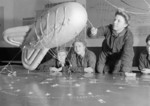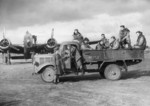WAAF: Women in the WW2 Royal Air Force
Contributor: Alan Chanter
 The Women's Auxiliary Air Force (WAAF) was established in June 1939 with Miss Jane Trefusis-Forbes (1899-1971) as its first Director. In World War I she had been one of the first group of women to wear khaki; joining the Women's Volunteer Reserve, formed in 1914 to set more men free for front line service. She had served in the ranks before becoming an officer, and was known to be an authority on dogs. Before being selected to head the WAAF she had been commanding a RAF Company of the Auxiliary Territorial Service (ATS). Beneath her peaked cap with her badge and double row of gold braid, a cheerful smile, clearly displayed an air of confidence that donated that she was a woman who would be able to get things done. Princess Alice, Duchess of Gloucester, (1901-2004), sister-in-law to King George VI became head of the Service in 1939 as Senior Controller, and was later appointed as Air Chief Commandant on 4 March 1943, when she took over as Director.
The Women's Auxiliary Air Force (WAAF) was established in June 1939 with Miss Jane Trefusis-Forbes (1899-1971) as its first Director. In World War I she had been one of the first group of women to wear khaki; joining the Women's Volunteer Reserve, formed in 1914 to set more men free for front line service. She had served in the ranks before becoming an officer, and was known to be an authority on dogs. Before being selected to head the WAAF she had been commanding a RAF Company of the Auxiliary Territorial Service (ATS). Beneath her peaked cap with her badge and double row of gold braid, a cheerful smile, clearly displayed an air of confidence that donated that she was a woman who would be able to get things done. Princess Alice, Duchess of Gloucester, (1901-2004), sister-in-law to King George VI became head of the Service in 1939 as Senior Controller, and was later appointed as Air Chief Commandant on 4 March 1943, when she took over as Director.
The fundamental object for the existence of the WAAF was to ensure that no aircraft was ever grounded if men who should service and maintain them were employed on duties which could realistically be undertaken by women. On 3 September 1939, the day war was declared between Britain and Germany, the Women's Auxiliary Air Force comprised 234 officers and 1,500 airwomen, but within a week some 7,000 volunteers had been found, and by 1 January 1940 the WAAF strength had increased to 359 and 8,403 respectively. The age limit was from eighteen to forty-three years, with an extension to fifty years for women who had previously served in the old WRAF (disbanded in 1920) whose experience made them suitable for employment in technical trades such as fitters and riggers. Most however were young girls, some of whom looked little more than schoolgirls. A little make up was permitted provided it was not excessive - circumstances did not favour vanity. A smart uniform, three weeks leave a year and free travel permits added to the volunteer's benefits even if food and amenities could frequently be stark and uncomfortable.
At the start there was little time for specialized training. New recruits, many of whom had fathers or brothers serving in the RAF, were appointed to jobs as close as possible to their civilian employments. Girls with good shorthand skills would work as station clerks, cooks went as cooks, seamstresses as balloon fabric repairers, waitress became mess orderlies, telephone operators went to run RAF exchanges and drivers went to motor transport sections, recruiting was so fast that there was soon a surplus of good cooks and other experienced workers which led to more trades becoming open to WAAF personnel.
By the Battle of Britain, less than a year after the outbreak of war, WAAFs were actively employed in plotting aircraft and radar signals, interpreting reconnaissance photographs, debriefing aircrew after raids, packing parachutes and running communications. In fact by 1944 almost all the RAF's meteorological officers were women. Other roles taken on by the WAAFs would include dental surgery attendants, equipment assistants, sick quarter attendants, teleprinter operators, instrument mechanics and even motor cycle despatch riders. Throughout 1940 women would be substituting for men in some 18 RAF trades, and by October 1945 the WAAF were successfully substituting for men in 15 officer categories and 59 airmen trades. The one area always denied by Air Force regulations was that women were forbidden to fly - in fact it was against the rules for an airman to even take them on a passenger flight.
One of the best kept secrets of the war was the "Y (interception) service". WAAFs who could speak German monitored radio transmissions, and by listening carefully to the "chatter" of German pilots were able to build up a picture of the Luftwaffe order of battle - a detailed list of the units attacking Britain and where they were based. Horribly, during the Battle of Britain they frequently had to listen to the screams of pilots as they fell to their deaths in burning planes.
A few WAAF were selected to serve as clerks (special duties) - a dull name which hid their real task of manning the operations rooms, radio interception stations, and most importantly the "top secret" radar stations, where personnel, often members of the WAAF - sat intently studying the blips on a cathode-ray tube. As it was essential to distinguish Allied aircraft to avoid any "blue-on-blue" incident RAF planes were fitted with an IFF (Identification Friend or Foe) device which provided the operators with a stronger signal on their screen. Information of "enemy blips" was relayed by telephone to Fighter Command Headquarters at Bentley Priory where other WAAFs assisted the Sector Controller in plotting the paths of squadrons in the air. Assistant Section Leader (Corporal) Joan Hearn was one of the operators at the Poling Radar Station which was little more than a collection of wooden huts protected by sandbags, with a new bomb-proof bunker still under construction, and with no nearby RAF barracks available for the women, they were billeted in a suite of rooms at Arundel Castle. She recalled years later that the rooms came complete with their own Butler to serve them meals.
One vital task carried out by the women of the WAAF was to inspect and fold parachutes prior to each mission. Many aircrew would owe their lives to the skill of these ladies.
In 1940, the Air Ministry investigated the possibility of employing WAAF airwomen as barrage balloon operators, despite the protests of Air Officer Commanding Balloon Command and his WAAF Staff Officer at the time, who expressed doubts whether women would have the physical strength and stamina for the task. Nevertheless in April 1941 twenty balloon fabric workers, all volunteers, underwent a training course in London, and later the first batch of volunteers were posted to a balloon centre for a 10 week training course. They were found to be highly competent in their new trade. Thereafter the numbers rose rapidly, first on a scale of twenty WAAF substituting for ten male airmen, but eventually replacing the men in the ratio of 14 to nine. By the end of 1942 no less than 15,700 WAAF balloon operators had replaced 10,000 airmen, releasing the latter for other essential duties. Since the 66-foot long and 30-foot high balloons, when inflated with 20,000 cubic feet of hydrogen and tethered to the ground by steel cables, could be hard to control the winch driver needed all her skill and concentration to get the balloon off the ground or hauled back down again. These girls would need to work as a highly efficient team - a fraction of a second late and the two girls controlling the balloon could receive some quite severe rope burns to their hands. In January 1943, when Balloon Command was reduced in size temporarily, large numbers of WAAF operators were declared redundant and diverted to other duties. The WAAF trade of Balloon Operator (Group II) was finally declared obsolete in 1944 and Balloon Command was officially disbanded on 5 February 1945.
Despite being a part of the framework of the Royal Air Force the WAAF maintained a number of unique features quite different from those in other services. For instance, WAAF officers and non-commissioned officers (NCOs) had greatly restricted powers of command over the male personnel of any rank, yet RAF male officers and NCOs had almost full disciplinary powers over the women at work. Similarly saluting was not technically enforceable (although mostly it was conducted out of curtesy) and WAAF officers were not permitted to be on the boards of Court Martials. WAAF administration officers were generally regarded by station commanders as merely advisors on pure WAAF matters with no laid down executive authority. At first disciplinary charges could not be dealt with summarily within the individual's parent unit, but could only be proceeded with by a full court martial, regardless of how trivial the matter might be. As female volunteers they could not be charged with desertion of absence without leave, which in simple terms meant that no punishment could be enforced in the usual service manner - an airwomen had to agree to be punished and, if she declined to accept a punishment, could simply leave the service without notice. Such undesirable procedures were finally resolved in April 1941 by the Defence (Women's Forces) Act which introduced more sensible modifications to apply to women's discipline. Despite later attempts to widen the powers over WAAF personnel in the context of disciplinary procedures the 1941 decision would remain unaltered until the end of the war.
Nor were the Women saved from the privations and hardships found on many wartime stations. Nevertheless through their energy and devotion to their duties the WAAF volunteers would succeed splendidly and many hundreds of WAAFs received honours and awards for gallantry. In one famous case Corporal Daphne Pearson heroically pulled Pilot Officer Bond, from his crashed Anson moments before the 120-pound bombs still on board exploded. This brave action earned her a commission and the British Empire Medal for gallantry (later exchanged for the George Cross - the first George Cross awarded to a woman).
While some station commanders stubbornly refused to accept the context of women in uniform, or would not take seriously WAAF involvement in military activities, it was not long before many male officers would display great admiration for the superb bearing, coolness and courage that was displayed by WAAFs in frontline airfields, particularly during the Battle of Britain when airfields frequently became the targets for enemy attacks. These young girls, many still under 21 years of age, typically remained at their posts despite strafing, bombing, and scenes of carnage and horror. Their refusal to quit is all the more praiseworthy when it is remembered that each girl had it within her own decision whether to desert or to remain among such terrifying conditions. In one classic case, Corporal Joan Hearn at Poling radar station, stubbornly remained in her post, relaying information to Bentley Priory's Filter Room, even while German dive bombers blasted the site into rubble; only leaving when physically ordered out by an officer.
In the terms of pay the WAAF volunteers suffered inequality with their male counterparts; receiving roughly two-thirds of the daily rate received by men in similar rank. Their pay was set at one shilling and four pence (1s 4d) a day on joining rising to two shillings and four pence (2s 4d) on mustering as an airwomen first class. Some specialist trades like clerks and equipment assistants did receive two shilling and tuppence (2s 2d) on entering with an additional six pence when mustered as airwomen and there were higher rates on promotions. Their scale of ration allowance was also much lower - the official reasoning being that women needed and consumed less food than the men. It was not until 1944 that the disparity began to be amended with equal ration allowance for WAAF officers and certain other strenuous trades such as balloon operators.
The first WAAF Recruit Depot opened on 30 October 1939 at West Drayton. It was by no means a satisfactory location, having been in use as an RAF transit camp and lacked most amenities beyond crude accommodation and barely adequate messing facilities. Nevertheless, the enthusiasm of early recruits, plus a diligence and keenness among the understrength WAAF staff, overcame most of the discomforts there. West Drayton remained the WAAF recruit depot until 17 September 1940, when the RAF resumed command in order to inaugurate radar training facilities for airmen. The WAAF Depot was then moved to Harrogate, Yorkshire, then to Bridgnorth, Shropshire, as No. 1 WAAF Depot. On 30 December 1940 No.2 WAAF depot was opened at Innsworth, near Gloucester, as the central reception and training centre for WAAFs in southern England. No.3 WAAF depot was inaugurated at Morecombe, Lancashire, on 1 October 1941 as a training centre only, but eventually closed as such on 25 February 1943, after which RAF Wilmslow in Cheshire would commence receiving and training WAAF recruits from northern England. In May 1943 further entry into the service was temporarily halted by the Ministry of Labour, at which time WAAF strength stood at 182,000; training being resumed at Wilmslow from 15 August 1943 for all new WAAF recruits.
The National Service (No. 2) Act became law on 18 December 1941. Its terms made Britain the first nation to conscript single women and childless widows between the ages of twenty (reduced to nineteen in 1943) and thirty for military service. In theory this meant that women could be called up to serve in one of the women's auxiliary services (although most conscripts would be directed into the ATS, munitions industry or civil defence). It did, however, rather change the purely voluntary nature that had been existing in the WAAF.
WAAFs were rarely deployed overseas, and then only as volunteers. Three officers in the cypher trade went to Washington, United States, in mid-1940 and a year later just 29, all officers, the were based in the in the US, Canada and Egypt. Non-commissioned ranks were not accepted for overseas duty until 1943, and then mainly to the Middle-East. However, by July 1945, WAAF officers and airwomen would be found serving around the world with detachments in France, Belgium, Germany, India, Ceylon, Bermuda, Bahamas, Labrador, Newfoundland, Norway and Australia. By the end of the war approximately a quarter of a million women had served in the WAAF ranks, relieving an estimated 150,000 men for redeployment to front line services. This represented some 16% of overall RAF strength at the peak of the conflict, and 22% of RAF strength in UK Commands.
Sources:
Chas Bowyer: Royal Air Force Handbook 1939-1945 (Ian Allan Ltd, 1984)
Peter Heppllewhite: World War II in the Air (MacMillan Children's books 2001)
Walter Hutchinson (Editor): The Women's Auxiliary Air Force -Women Help the Royal Air Force, pp289-294 (Library Press, Pictorial History of The War, Vol 1)
Rupert Matthews: Heroes of Bomber Command -Lincolnshire, pp143 (Countryside Books, 2005)
Juliet Gardiner: Wartime Britain 1939-1945 (Headline Books Publishing, 2004)
Last Major Update: Aug 2021
WAAF: Women in the WW2 Royal Air Force Timeline
| 30 Oct 1939 | The first WAAF Recruit Depot opened in West Drayton, Middlesex, England, United Kingdom. |
| 17 Sep 1940 | The British Royal Air Force resumed operations at RAF West Drayton, Middlesex, England, United Kingdom for radar training, thus forcing the WAAF recruit depot at that location to relocate to Harrogate, Yorkshire, England and later to Bridgnorth, Shropshire, England. |
| 30 Dec 1940 | No. 2 WAAF Depot was opened at Innsworth, near Gloucester, Gloucestershire, England, United Kingdom as the central reception and training centre for WAAFs in southern England. |
| 1 Oct 1941 | No. 3 WAAF Depot was opened at Morecombe, Lancashire, England, United Kingdom; it was a training centre. |
| 25 Feb 1943 | No. 3 WAAF Depot at Morecombe, Lancashire, England, United Kingdom was closed. |
| 15 Aug 1943 | WAAF recruit training operations resumed at RAF Wilmslow in Cheshire, England, United Kingdom. |
Photographs
 |  |  |  |
WAAF: Women in the WW2 Royal Air Force Interactive Map
Please consider supporting us on Patreon. Even $1 per month will go a long way! Thank you. Please help us spread the word: Stay updated with WW2DB: |
Visitor Submitted Comments
1 Apr 2023 07:05:04 AM
Are there any free sites where I can find my parents' war records for WW"? Looking for RAF anf WAAF. Thanks.
24 Nov 2024 02:08:14 AM
My nan is 98 she was in the WAAF. She knows her number, regiment etc but seems to have been missed/forgotten. How do i help her to register her details?
All visitor submitted comments are opinions of those making the submissions and do not reflect views of WW2DB.

- » Wreck of Teruzuki Found (27 Jul 2025)
- » USS Orlean's Bow Found (22 Jul 2025)
- » The Emperor of Japan Planned to Honor WW2-era Japanese POWs in Mongolia (4 Jul 2025)
- » US State Lawmaker John Winter Caught Using Racial Slur "Jap" and Apologized (11 Jun 2025)
- » US Government Plans to Purge WW2 Information (17 Mar 2025)
- » See all news
 |
- » 1,181 biographies
- » 337 events
- » 45,132 timeline entries
- » 1,249 ships
- » 350 aircraft models
- » 207 vehicle models
- » 376 weapon models
- » 123 historical documents
- » 261 facilities
- » 470 book reviews
- » 28,427 photos
- » 365 maps
Winston Churchill
Please consider supporting us on Patreon. Even $1 a month will go a long way. Thank you!
Or, please support us by purchasing some WW2DB merchandise at TeeSpring, Thank you!
24 Mar 2023 12:48:53 PM
My mothers war time WAAF record says 'Betchley Park' with a cross through it and then 'central signals area'. Does anyone know where this would be?